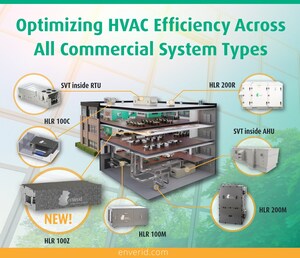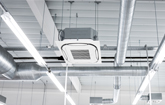WESTWOOD, Mass., March 23, 2021 /PRNewswire/ -- enVerid Systems, a leading provider of indoor air quality solutions, shared a statement on the CDC's new school opening guidelines and expert recommendations on HEPA air filtration units.
"The CDC's new 3ft physical distancing guidance will allow for more students to return to school for invaluable in-person instruction and peer socialization, and for our economy to continue to revive," said Christian Weeks, CEO of enVerid Systems. "With the increased density of students, and with the rise of new variants, schools must continue to be vigilant in following a layered approach, applying key mitigation strategies such as masking, hand washing and improved ventilation and filtration. enVerid urges schools to adopt the proven approach encouraged by the CDC, ASHRAE and indoor air quality (IAQ) experts of deploying in-room HEPA air filtration units to achieve the recommended target of 5-6 air changes per hour (ACH) - especially in high-congregation areas such as classrooms, cafeterias, music rooms, and entryways."
Following are important recommendations on choosing and deploying HEPA air filtration units for K-12 schools:
- Look for HEPA or True HEPA designation. Other naming conventions likely indicate less than 99.99% cleaning efficiency.
- Ensure the filtration unit is robust enough to achieve 5-6 air changes per hour (ACH) as recommended by the Harvard T.H. Chan School of Public Health at acceptable noise levels. This means that the air inside a classroom will be exchanged with clean air one time every 10-12 minutes. A good rule of thumb for sizing filters is 300 cubic feet per minute (CFM) of airflow for every 500 ft2.
- Experts recommend center of room positioning for HEPA filtration units, and ideally raised off the ground. A ceiling-mounted air purifier draws infected aerosols up and away from students and allows for unencumbered airflow and noise reduction. A New York Times visualization shows how infected aerosols ascend and concentrate in the upper regions of a room before infiltrating an entire classroom.
- Loud units disrupt instruction and will likely be turned down or off by teachers. Review decibel (dBA) ratings at the optimal fan speed for the desired air exchange rate. Classroom acoustic recommendations from ANSI and Well are 35 dBA and 35-45 dBA, respectively. Many in-room air filters exceed the recommended sound levels, so schools should look for the quietest options available that deliver the target ACH.
- Select HEPA filters that have been tested by an independent 3rd party and verified to perform as marketed.
- Think beyond the pandemic and choose a durable, lasting investment versus a short-term, disposable option. Post-pandemic, fixed HEPA units will remain part of a school's infrastructure protecting staff and students from pollution, allergens, and seasonal flu and other contagious viruses. Schools near city centers, highways or those in wildfire-prone areas will benefit from lowered pollution levels, decreased exposure to smoke, and other asthma triggers addressed by HEPA filters.
"With respect to air cleaners for airborne pathogens, there is a very clear hierarchy of performance," said Raefer Wallis, global indoor air quality expert and Founder of RESET. "At the very top, we find ceiling-mounted filtration systems that allow for a very high level of control in specific areas because they are ducted and unobstructed by objects in a room. This is extremely important for issues like COVID-19, where aerosolized viruses can be removed at the source. The next level down is portable filters, which are 20-50% less effective than their ceiling mounted counterparts mainly due to challenges with placement in a space. Last is traditional central filtration systems, which force virus particles to travel a long distance prior to being removed."
To learn more see our Guide to Improving Classroom Air Quality for COVID-19 Mitigation.
About enVerid Systems, Inc.
enVerid Systems helps buildings achieve ESG (Environmental, Social, and Governance), healthy building, and cost saving goals by improving indoor air quality while saving money and reducing energy consumption and carbon emissions. For new HVAC systems, enVerid's award-winning HVAC Load Reduction® (HLR) modules enable immediate capital cost savings. HLR modules also deliver up to 40% HVAC energy savings and superior indoor air quality in new and existing buildings. enVerid's air filtration products remove particulate and microorganism contamination from indoor air without the significant cost of upgrading mechanical systems and increasing mechanical ventilation rates. enVerid's products are deployed in commercial, academic, and government buildings globally. enVerid's HLR Modules are ASHRAE Standard 62.1, LEED®, and WELL compliant and eligible for utility rebates. For more information, please visit https://enverid.com.
SOURCE enVerid Systems

WANT YOUR COMPANY'S NEWS FEATURED ON PRNEWSWIRE.COM?
Newsrooms &
Influencers
Digital Media
Outlets
Journalists
Opted In





Share this article